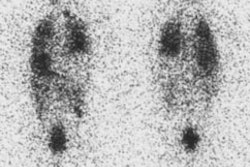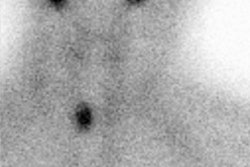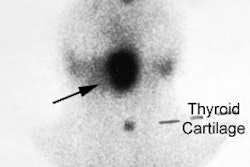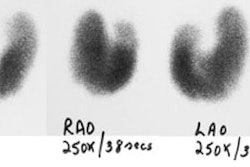J Nucl Med 2000 Nov;41(11):1868-75
Therapeutic 131I in outpatients: a simplified method conforming to the Code
of Federal Regulations, title 10, part 35.75.
Coover LR, Silberstein EB, Kuhn PJ, Graves MW.
The Code of Federal Regulations, title 10, part 35.75 (10CFR35.75), provides
greater latitude and flexibility in the dosing and management of outpatients
treated with therapeutic 131I than did preceding regulations. Prescribing
physicians should consider applying these new regulations to enhance patient
convenience and lower the cost of managing appropriate outpatients. Managed care
organizations and third-party payers may require that all eligible patients be
treated as outpatients or that justification for hospital admission be
specifically documented. To facilitate application of the code and guidelines,
maximum 131I doses for patients undergoing thyroid remnant ablation, therapy for
metastatic or recurrent thyroid cancer, or therapy for hyperthyroidism have been
calculated and summarized in tables. METHODS: A model was developed that
calculates the maximum dose of 131I that may be dispensed to an outpatient. This
model complies with 10CFR35.75. The maximum dose is calculated as a function of
5 variables: the occupancy factors for 3 periods after dose administration, the
fractional uptake of 131I by residual thyroid tissue or metastasis, and the
duration of constrained activity. Occupancy factor, a key new concept in the
regulatory guidelines, is a physician estimate of the time that a treated
patient will be near the individual with whom the patient will spend the most
time after treatment. The model also considers 3 constants: the effective
half-life of 131I during the preequilibrium period, and the effective half-lives
of 131I in both the thyroidal component and the extrathyroidal component during
the equilibrium period. Tables for maximum allowable patient 131I doses were
derived on the basis of this model. RESULTS: Through dosing charts, maximum 131I
therapy doses may easily be calculated. Most outpatients undergoing thyroid
remnant ablation, therapy for metastatic or recurrent thyroid cancer, or therapy
for hyperthyroidism may be treated with 7400 MBq (200 mCi) 131I or more.
CONCLUSION: If the prescribing physician understands the concept of occupancy
factor and how to use the dosing charts, our model facilitates application of
and adherence to 10CFR35.75.



